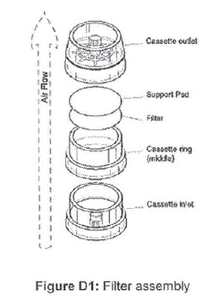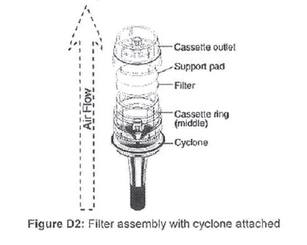


Mine Health and Safety Act, 1996 (Act No. 29 of 1996)RegulationsGuideline for a Mandatory Code of PracticeOccupational Health Programme (Occupational Hygiene and Medical Surveillance) on Personal Exposure to Airborne PollutantsAnnexuresAnnexure E : Background information, sampling and analysis on particulates2. Standard procedure for the assembly of the sampling train |
| 2.1 | Introduction |
Filters are used to sample airborne chemical hazards in particulate form. Particulate samples are collected using a small, porous filter typically 25mm or 37mm in diameter. A cyclone is used when the measurement of respirable dust is required. Respirable dust particles are those particles small enough to reach the alveoli of the lung. When using a cyclone, the larger particles will be removed from the air by centrifugal force and fall into the bottom of the cyclone, while the smaller particles (respirable) will pass through the cyclone and be collected on the filter.
| 2.2 | Equipment required |
| (a) | Air sampling pump capable of sampling at the recommended flow rate with the sampling medium in line. |
| (b) | Air flow calibrator, such as an electronic calibrator. |
| (c) | Filters, support pad or, screen and cassette blanks as specified in the method |
| (d) | Cyclone, size as specified in the method. |
| (e) | Filter cassette holder. |
| (f) | Optional equipment, such as cassette sealing bands. |
| (g) | To determine the correct flow rate for the chemical being sampled, refer to the appropriate analytical method. |
| 2.3 | Preparing the filter cassette |
The filter cassette is used to hold the filter securely in place during sampling. The cassette consists of an inlet, an outlet and possibly a middle ring or extension cowl. The cassette with all three sections can be used with the inlet in place (closed face) or with the inlet removed (open face) depending on the method.
| 2.3.1 | Without cyclone - see Figure D1 |
To load the cassette, place a cellulose support pad or stainless-steel screen in the outlet of the cassette and add the appropriate filter. Add the extension cowl or middle ring if required then close the cassette firmly with the inlet. Insert the plugs into the inlet and outlet.

| 2.3.2 | With cyclone - see Figure D2 |

Place a cellulose support pad in the outlet of the cassette and add the appropriate filter. Add the middle ring and place the cyclone securely into this ring. Insert the plug into the cassette outlet, The cyclone must meet the ISO/CEN /ACGIH size selective curve.
| 2.4 | Setting up the sampling train. |
| 2.4.1 | Without a cyclone |
Ensure that the pump is in the correct flow mode. When calibrating the flow use the sampling train that is to be used in the field. Remove the plugs from the cassette and use flexible tubing to connect the filter outlet to the pump intake and the filter inlet to the external flow meter.
| 2.4.2 | With a cyclone |
Ensure that the pump is in the correct flow mode. When calibrating the flow, use the sampling train that is to be used in the field. Insert the cyclone calibration chamber over the cyclone and ensure that it fits securely to avoid leaks. Remove the plug from the cassette and use flexible tubing to connect the filter outlet to the pump intake and the calibration chamber to the external flow meter. The cap on the stem of the cyclone (grit pot) should remain in place during calibration and use. The cyclone must meet the ISO/CEN/ACGIH convention for respirable particulate sampling.